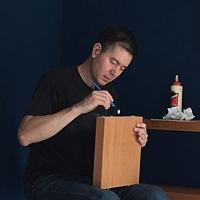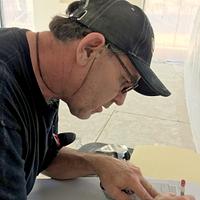Share your craft projects
Make new craft buddies
Ask craft questions
Blog your craft journey

Ron Stewart
861 posts
and
24 followers
in about 3 years
in about 3 years
More from Ron Stewart
Mobile Sewing Thread Storage Rack #10: Finishing and Final Assembly
This is
part 10
in a
11 part
series:
Mobile Sewing Thread Storage Rack
...
-
Building the Triangular Support Brace
-
Finishing and Final Assembly
-
Stabilizing the Rack, and Making Some Final Tweaks
...
- Building the Triangular Support Brace
- Finishing and Final Assembly
- Stabilizing the Rack, and Making Some Final Tweaks

With the brace finished, the rack was almost ready to assemble. I started by adding the top cap with some dowel joinery.

I also drilled some holes for (unglued) alignment dowels in the base and bottom edge of the rear panel. Those dowels enabled me to dry-fit the cart without using screws. Now I could verify that the racks could swing open without contacting the rear panel.

It was fun seeing how the finished rack would look with the racks folded closed.

Before sanding everything down to 220-grit, I also counterbored and drilled screw holes in the bottom of the base and skirt. I’d glue the brace to the rear panel and cap to form an upper subassembly that would be attached to the base with screws. I knew I’d need to tweak the dowel pivot hinges and washers, so I needed to be able to disassemble the rack.
With that done, I wiped on three coats of satin Arm-R-Seal to all the parts. As usual when prefinishing, the hardest part about that was finding a way to hold the parts while applying the finish and supporting them afterward to dry. I used a long clamp as a handle for the brace. I placed the base on a stack of bench cookies. The rear panel’s dado balanced on a long strip of scrap.

Because I had previously applied finish to the insides of the racks, I could hang them on the ends of more long clamps.

I left everything alone for a day or two before attaching 2” x 1 3/8” butt hinges to the two rack pairs. To give the rack sides a bit of expansion room, I used high-tech spacers (pieces of cardboard torn off a box of Mini Wheats cereal). The hinges are so thin I didn’t worry about cutting mortises for them.

I had applied one coat of finish inside the base, so I hadn’t attached the 1” casters (which have posts that screw into threaded inserts) earlier. When I attached them, I discovered a problem. I had drilled the insert holes about 1/16” too close to the edges. Some of the caster wheels rubbed the insides of the skirts and couldn’t rotate 360 degrees. Given that the base had an uncured finish on it, I didn’t want to muck around with it too much. I just placed it upside down on a padded surface and used a Dremel and grinding wheel to hog out some material where the wheels rubbed. It’s crude and ugly, but it will also be hidden, so I didn’t agonize about it too much.

Next, I glued the brace to the rear panel, and the cart was ready for assembly. Here, you can see the alignment dowels and screw holes in the base. I used four screws to attach the base—two 1 1/8” fine thread pocket screws in the brace and two into the rear panel.

The last step was cutting the 144 5mm dowels for the thread spools and bobbins. My first thought was 144 passes with my crosscut sled. The only problem with that (aside from it taking forever) is that I’d get some tear-out.
To prevent that, and to speed up the job, I made a simple jig from a block of scrap about 1/2“ wider than the dowels’ length. I drilled eight holes through the edge of that block close to the bottom. Then I set the fence to match the dowel length and cut a slot partially through the underside of the block (deep enough to extend past the holes).

To use the jig, I pushed eight dowel rods at a time (they came in 12” lengths) though the jig until they touched the fence.

I made a pass through the blade to cut all eight dowels (fully supported on both sides of the cut).

Then I pushed the cut dowels out and repeated the process. It went quickly, and the cuts were clean, requiring only a quick spin against a piece of sandpaper to smooth.

I didn’t think the dowels needed any finish, and my wife agreed, so all I needed was a small drop of glue (not enough to squeeze out through the top of the hole) in each spool block hole, and the cart was “finished.”

More correctly, the cart was ready to take inside for some testing. From the beginning, I was worried that it would be back heavy and would want to fall over backward. Soon, I’d know for sure.
11 Comments
man that came out fantastic ! that was a lot of work but im sure the wife is gonna really appreciate the effort given. well done.
working with my hands is a joy,it gives me a sense of fulfillment,somthing so many seek and so few find.-SAM MALOOF.
Do you think Cheerios box material would work, or just the Mini Wheats??
Great job!
Great job!
That came out pretty nice. Got it done quick too. Makes me wish I sewed.
Figuring out how to do something you have never done is what makes a good challenge.
Thanks, Pottz, Barb, and Bently!
Barb, you can't possibly be serious. Mini Wheat biscuits are stable in all three dimensions. A Cheerio is stable in just one. Using a Cheerio box spacer at the wrong orientation would have caused the two rack halves to roll away from one another, making the hinges all wonky. :-)
Bently, I don't do anything quickly (except writing things). It took me almost a month to finish this thing (not including the initial design work).
Barb, you can't possibly be serious. Mini Wheat biscuits are stable in all three dimensions. A Cheerio is stable in just one. Using a Cheerio box spacer at the wrong orientation would have caused the two rack halves to roll away from one another, making the hinges all wonky. :-)
Bently, I don't do anything quickly (except writing things). It took me almost a month to finish this thing (not including the initial design work).
Almost there!
Ryan/// ~sigh~ I blew up another bowl. Moke told me "I made the inside bigger than the outside".
Ron
excellent work!
excellent work!
Petey
Of course! 🤦♀️ So embarrassed to think Cheerios might be a suitable substitute. I have so much to learn about woodworking.
Looks great! Clever dowel cutting trick.
Looks massive on the blue rug there with its wings spread open. Very "furniturey" looking, sets a high standard for future storage accessories!
Don’t feel bad, Barb. As you gain experience, you’ll get more adept at making things up. 😁
Thanks, Ross.
Thanks, Splint. It’s about 36” wide tip to tip when unfolded. It doesn’t look as big in the room.
Thanks, Ross.
Thanks, Splint. It’s about 36” wide tip to tip when unfolded. It doesn’t look as big in the room.
That's why I'm here...to learn!














